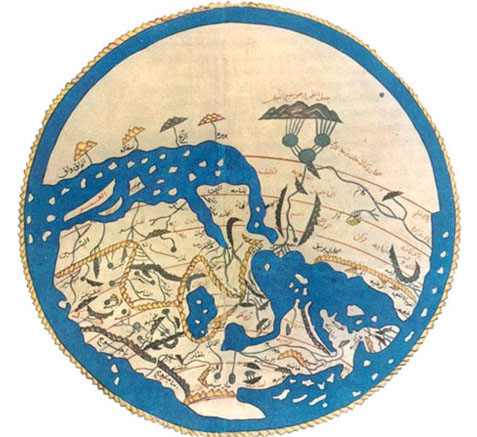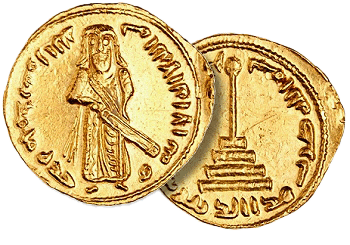“Medieval Mediterranean Coinage: An Introduction”
Mediterranean Studies Summer Skills Seminar
23—26 June 2025 • Remote
The Summer Skills Seminar, “Medieval Mediterranean Coinage: An Introduction” will be held via Zoom from Monday, 23 June to Thursday, 26 June 2025 from 10am to noon and 1pm to 3pm MDT.
Course overview
Coinage was a part of the lives of virtually all inhabitants of the regions around the Mediterranean from late antiquity to the later Middle Ages. Coins served as a means of pay, of commerce, of savings, and were one of the few emanations of their government that medieval people experienced in daily life. This course will begin with an overview of the Late Roman coinage, which lived on in the coinage of the Byzantine Empire, and in the gold coinage of the Islamic states. In the same period, the Sasanian coinage of Persia gave way to the silver Islamic coinage. In Mediterranean Europe, new coinages sprang up, based often on local rather than national polities. The course will examine the later development of the Byzantine, Islamic, and Mediterranean European coinages, with special emphasis on the interactions of the three coinage traditions during the Crusading period.
Topics Covered
The minting, circulation, and economic aspects of medieval coinage will be explored. There will be an introduction to the use of die study, metrology, and chemical analysis in the study of medieval coinages. The reading of legends (inscriptions) of medieval coins will be explained as will be the practice of immobilization, the repetition of old and inaccurate information on coins. The contributions of hoard and excavation study to knowledge of the minting and circulation of medieval coinages will be discussed. Such topics as coin debasement, Gresham’s Law, and the challenges of bimetallic monetary systems will be explained with medieval examples. The general developments of the three coinage traditions will be illustrated with examples, as will the imitation and cross-adaptation of coinages among Byzantine, Islamic and European minters.
Structure and Goals
On the first day of class, each student will select a coin of relevance to their overall field of medieval interest; these can be taken from online sources or from personal collections. The student’s choices of coins of personal interest will be reflected in the emphases and examples illustrated in the remainder of the course. On the second day, each student will introduce their coin to the class and explain its imagery and inscriptions. On the third day, each student will introduce to the class the specialized literature on the coinage they have selected. On the final day, each student will present a hoard or excavation in which coins of the type they have chosen are present and will comment on how such finds inform us of the circulation of the coinage.
By the end of the course, each student will have a deeper understanding of one coinage, exposure to the information on other coinages shared by their colleagues, and an overview of the monetary development of the medieval Mediterranean in which these coinages functioned
Participants said:
• “This course was fantastic. The only way in which class presentations could have improved would have been, perhaps, the use of headings in presentations as pedagogical markers. E.g., "Now we're moving into coins of this region/time period/with X crossover feature..." Without this, students need to fill in the blanks as to how each new coin is related to those already studied (which certainly can, of course, be its own type of pedagogical intention).”
• “I wanted to thank Professor Stahl for teaching this course with three students. We were all the luckier for being able to work with him in a small class!”
Faculty
Alan Stahl has been Curator of Numismatics in Princeton for over two decades, a position that he took after two decades as Curator of Medieval Coinage at the American Numismatic Society. He teaches regularly in Princeton’s departments of Art and Archaeology, Classics, and History. He also teaches the summer course in Byzantine numismatics at the Dumbarton Oaks Library and Research Center. He holds a Ph.D. in medieval history from the University of Pennsylvania and has been a recipient of the Medal of the Royal Numismatic Society, a lifetime achievement award. Among his ten books and more than 120 articles are the prize-winning Zecca: The Mint of Venice in the Middle Ages, and The Book of Michael of Rhodes: A Fifteenth-century Maritime Manuscript. His book The House of Condulmer: The Rise and Decline of a Venetian Family in the Century of the Black Death was published in 2024. He has written extensively on the coinage of medieval Venice, the coinages related to the Crusades, and the coin finds from the excavations of ancient and medieval Antioch.
Go to Program/Syllabus
Participants
Eleanor Congdon (Humanities and Social Sciences, Youngstown State University)
Eleanor A. Congdon took her PhD at Gonville and Caius College, University of Cambridge, under the guidance of Prof. David S. H. Abulafia. Her 1997 dissertation “Venetian Merchants in the Western Mediterranean 1398-1405” was based on extensive research in the Datini correspondence in Prato, the governmental records found in the Archivio di Stato di Venezia, and a very brief research foray in Barcelona with the help of Maria Theresa Ferrar I Mallol.
Her interest in merchant correspondence started during her MA work at the University of Minnesota when she stumbled upon a small cache of Venetian letters dating to the 1480s about Venetians doing business in Syria. She continues to work on both of these projects as her teaching load allows. She also follows her family’s interest in genealogical history, concentrating on the prolific, but little known Gothic Revival architect Henry Martyn Congdon. She has reconstructed his portfolio, finding 65 churches, 28 church out-buildings, 40 private homes, and many other works spread from Mississippi to New Hampshire and Colorado (including a church in Boulder) to New York City during a career which lasted from 1860 to 1922.
These projects have led her, after nearly 30 years of teaching, to have explored many tangential topics and disciplines. She has been employed at the teaching-school, Youngstown State University, having little time for research or writing because of her teaching duties. As her career is winding down, she hopes this summer’s courses will serve to sharpen her skills so that her three major research projects can finally come to fruition.
Erica Ferg (Religious Studies, Regis University)
Dr. Erica Ferg teaches courses on Islam, Christianity, Judaism, Mediterranean religious history, and religious studies theories and methods. Her doctorate is in the Study of Religion, and her area of specialization is Eastern Mediterranean comparative religious history. Her research focuses on Mediterranean comparative religion, religious texts, comparative linguistics, and archaeoastronomy. Prior to academia, Erica was a Persian linguist in the United States Air Force. Erica's first book, Geography, Religion, Gods, and Saints in the Eastern Mediterranean, was published in paperback in January 2022 by Routledge. Erica currently is at work on two book projects, titled Starry Nights: A Celestial History of Religion in the Mediterranean, and a co-authored philosophy and religious studies book, titled Benighted Enlightenment: Belief, Religious Toleration, and the Legacy of the Christian Enlightenment.
Jason Rodriguez Vivrette (Middle Eastern Languages and Cultures, University of California Berkeley)
Jason Rodriguez Vivrette is Lecturer in Turkish in the Department of Middle Eastern Languages and Cultures at the University of California, Berkeley, as well as a PhD candidate in Comparative Literature. He holds an MA in Comparative Literature from UC Berkeley, as well as BA degrees in both Film and Italian Studies from the University of Southern California. Jason’s current research explores sea power and hydropoetics in the management of ‘unruly’ peripheries of Mediterranean and Middle Eastern worlds, with a focus on Ottoman and Italian crossings in Upper Mesopotamia and Kurdistan.
Through case studies bridging a variety of genres (travel-writing; cartography; numismatics; kısas-ı enbiyâ [biographies of the prophets]; the early novel), the project deconstructs how literal and figurative manifestations of 'water knowledge' coalescing in the early 16th century have been deployed as a way to control and exploit terrains and peoples deemed rebellious in relation to a dominant order of the sea. The project also importantly highlights counter-imaginaries, analyzing how the destructive tide of such water discourses has been stemmed, redirected, and/or repopulated through local literary practices.





